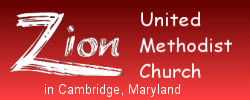|













| |
A Brief History of Zion
United Methodist Church
Zion Church, first known as
Garrettson Chapel, has a rich heritage dating back to 1780, just twenty years
after the first Methodist Societies were formed in America in 1760 and four
years before the first General Conference, the 1784 Christmas Conference at
Lovely Lane Chapel in Baltimore, at which the Methodist Episcopal Church was
founded. At that conference Francis Asbury and Freeborn Garrettson among others
were ordained elder, and Francis Asbury and Thomas Coke were appointed
Superintendents, an office later to be known as Bishop.
| The first Methodist sermon in Dorchester
County was preached by Rev. Freeborn Garrettson in 1779 at the home of
Squire Airey, near Salem, Maryland. There was so much excitement caused
by the preaching of Wesley’s Methodist doctrine, that in 1780,
Garrettson was arrested at the home of Mr. Airey for preaching without a
Maryland license and imprisoned for 16 days in the old Cambridge Jail,
which stood at what is now 613 Locust Street directly across the street from the present
Zion Church parsonage. The town’s people fed Garrettson through the jail
window where he daily held church services. Through the efforts of
Francis Asbury, Governor Thomas S. Lee of Maryland, President Caesar
Rodney of Delaware, and with his bail paid by Mr. Airey, Garrettson was
released from jail. Dorchester County remained a “hotbed of Methodism!” |
 |
Zion claims Freeborn Garrettson as
one of its founders. In fact, the three stained glass windows in the side of our
current sanctuary depict (l-r) John Wesley, Francis Asbury, and Freeborn
Garrettson. Garrettson hall is also named after Freeborn Garrettson. Up until
1800, the congregation of Garrettson Chapel was a Methodist Society likely
meeting in people’s homes. In 1800, a lot on the west corner of Mill and Church
Streets (now 312 Mill St.) was purchased and Garrettson Chapel, later known as
Zion Chapel, was erected. On April 18, 1802,
Bishops Asbury and Whatcoat visited the new Chapel.
| By 1845 the congregation had outgrown its
building on the west corner of Mill and Church Streets. The trustees
decided to relocate the church to the northwest side of Race street
about midway between Muir Street and Gay Street. The cornerstone of
the new church was laid in 1845 and the building was dedicated on August
19, 1846 by Bishop Edmund Storer Janes. The building was built of
granite, pointed and penciled with a 166 foot high steeple. The building was remodeled in
1881 and again in 1908. |
 |
| On Saturday, July 31, 1910, a fire
was discovered in the hay loft of LeCompt & Harper’s stables at 2:20 am
and subsequently swept through the Cambridge business district
destroying homes, businesses, warehouses, and Zion Methodist Episcopal
Church. While devastated by the loss, the congregation immediately made
plans for Sunday School which was held that same day at 2:15 pm at the Old Auditorium
Theater on Gay Street where the old City Hall now stands. Services were
subsequently held at Phillips Hall on the corner of Gay and Muse Streets where the
armory now stands. Phillips Hall was the temporary home of Zion until
the new building was completed. The value of the building was estimated at $25,000, but the
church only had $9,500 in insurance. Regardless, the trustees stated
that “no time will be lost in rebuilding.” This would not be the only
time that the Zion congregation’s building would be totally destroyed by
fire. |
 |
| In September, 1910 the Trustees purchased the lot on Locust
Street for $10,000, where the present Zion was built at a cost of $85,000. The
first service was held in 1912. Fourteen years later, the mortgage was burned in
1926. |
 |
| On January 1, 1950, a devastating fire totally destroyed Zion
Church, which was still in debt from the remodeling of 1949. Though
shocked and saddened, the congregation, under the leadership of the Rev.
Alton S. Miller, had the determination to go forward. |
 |
|
The decision was made to
rebuild. Assistance came from the entire community. The rebuilding was
completed in 1952. On Sunday, October
29, 1967, the mortgage burning ceremony was held during the pastorate of
the Rev. Otho G.
Brewer, Jr.
Through the generosity of Capt. Levi B. Phillips,
Sr. who died in 1946 leaving Zion a legacy, a lovely parsonage was built
next to the church. Constructed of granite, it was dedicated in 1952.
The Phillips-Roszelle Memorial Church Parlor was
planned during the pastorate of Dr. John E. French.
In 1968, when the Methodist Church merged with the
Evangelical United Brethren Church and Zion became Zion United Methodist
Church, the senior pastor, Dr. Howard M. Amoss, was a delegate.
During the pastorate of the Rev. William H. Owens
an Endowment Fund was established in 1972.
In 1973 a History and Records Room was decorated
and furnished by Mr. and Mrs. Granville Hooper. The Book of Remembrance
contains many important gifts made to Zion by its devoted members.
|
 |
The Zion congregation is grateful for the rich blessings God has bestowed
throughout the long and eventful history of our church and pray that God’s
guiding hand may continue to lead us in the future as in the past.
|
